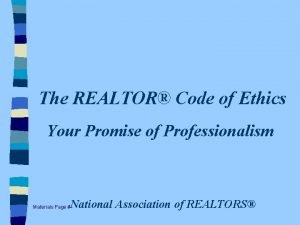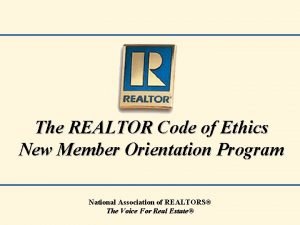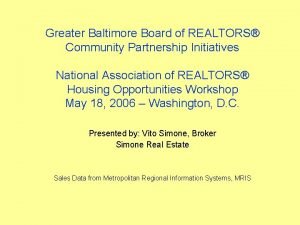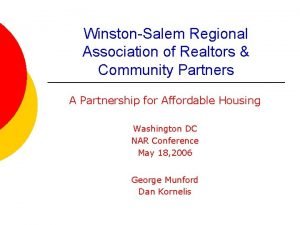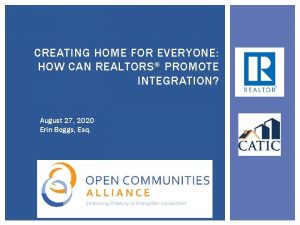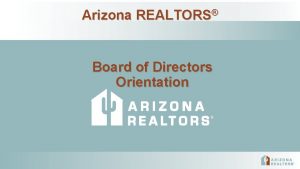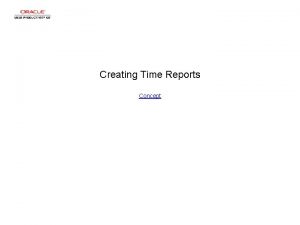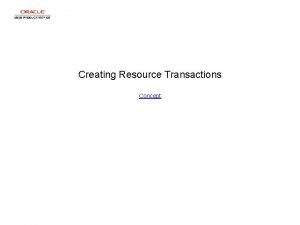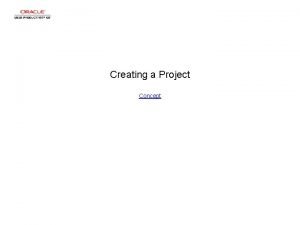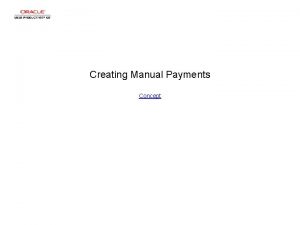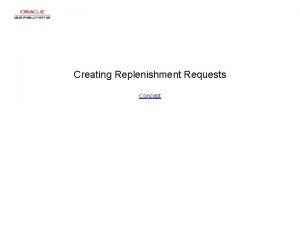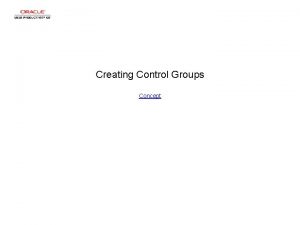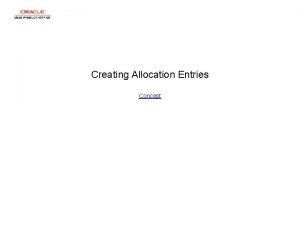Creating a Home for Everyone How can Realtors


























- Slides: 26

Creating a Home for Everyone: How can Realtors® promote integration? “Origins of Residential Racial Segregation and Evidence of Continuing Housing Discrimination” Presented by Fred Freiberg Wednesday, August 27, 2020 1

v Introduction/Overview of Presentation o Why Fair Housing Matters § Role of Real Estate Industry and Government in Creating Residential Segregation § Continuing Problem of Racial Discrimination in Housing 2

v Fair Housing History o Late 1800’s – Prior to Organized Real Estate Industry § No Pronounced Patterns of Residential Racial Segregation § Supreme Court Decision in Plessy v. Ferguson Established Legal Foundation for Segregation 3

v Fair Housing History o Early Formation of Organized Real Estate Industry § National Association of Real Estate Exchanges (1908) • Instructed members not to contribute to race-mixing (1913) 4

v Fair Housing History o Proliferation of Racial Zoning (1910) § Louisville, Kentucky Ordinance: “An ordinance to prevent conflict and ill-feeling between the white and colored races in the City of Louisville and to preserve the public peace and promote the general welfare, by making reasonable provisions requiring, as far as practicable, the use of separate blocks, for residences, places of abode, and places of assembly by white and colored people respectively. ’ (1914) § Buchanan v. Warley (1917) Racial zoning ruled unconstitutional by Supreme Court 5

v Fair Housing History o NAREE changed name to National Association of Real Estate Boards (NAREB) (1916) § NAREB advocated use of race restrictive covenants and development of homeowner’s associations to “protect” new developments 6

v Fair Housing History § Example of race restrictive covenant: Washington Highlands, Wauwatosa, Wisconsin (1919) “At no time shall the land included in the Washington Highlands or any part thereon be purchased, owned, leased, or occupied by any person other than the white race. This prohibition is not intended to include domestic servants while employed by the owner or occupant of any land included in the tract. ” 7

v Fair Housing History § NAREB adopted and enforced a new Code of Ethics. (1924) Article 34 of the Code of Ethics, which remained in effect until 1950 read: “A Realtor should never be instrumental in introducing into a neighborhood a character of property or occupancy, members of any race or nationality or individuals whose presence will clearly be detrimental to property values in that neighborhood. ” 8

v Fair Housing History § Local and state Boards of Realtors sanctioned and expelled Realtors who violated Article 34 of the Code of Ethics. § The General Counsel for the NAREB disseminated a model licensing agreement to States to encourage its adoption so that states could discipline or revoke the licenses of any real estate licensee who might violate the code of ethics. Thirty-two states adopted this agreement. § NAREB leadership coordinated and supported efforts of local boards to develop plans or “black belts” to restrict African American populations from moving to 9 white areas.

v Fair Housing History § NAREB developed and disseminated a Model Race Restrictive Covenant (1927). One provision of that model agreement stated: . “ 1. The restriction that no part of said premises shall in any manner be used or occupied directly or indirectly by any Negro or Negroes, provided that this restriction shall not prevent the occupation, during the period of their employment, of janitors’ or chauffeurs’ quarters in the basement or in a barn or garage in the rear, or of servants’ quarters by Negro janitors, chauffeurs or 10 house servants, respectively, actually employed as such for

v Fair Housing History § By 1928, half of all homes owned and occupied by white people in the nation had deeds with race restrictive covenants enforceable in state courts. o Development of Federal Housing Policy § Home Owners Loan Corporation (HOLC) (1934) • Use of Residential Security Maps (Redlining) 11

v Fair Housing History § Federal Housing Administration (FHA) • FHA Form 2082 “Racial Occupancy Designation” – Appraisers to note if neighborhood was “White, ” “Mixed, ” “Foreign, ” or “Negro” (1934) • FHA Underwriting Manual (1938) “Areas surrounding a location are investigated to determine whether incompatible racial and social groups are present, for the purpose of making a prediction regarding the probability of the location being invaded by such groups. If a neighborhood is to retain stability, it is necessary that the properties shall continue to be occupied by the same social and racial classes. A change in social or racial occupancy generally contributes to instability and a decline in values. ” 12

v Fair Housing History § Public housing operated on racially segregated basis (1930’s) § Veteran’s Administration (VA) establishes program to make mortgages available to returning veterans, but program adopts FHA discriminatory underwriting policies making most African American veterans ineligible for the program. 13

v Fair Housing History § By 1948, 85% of all new residential developments in the United States were racially restricted. § Supreme Court decision in Shelley v. Kramer ruled race restrictive covenants could not be enforced by courts, however decision did not preclude their voluntary use through the 1950’s and 1960’s. 14

v Fair Housing History § FHA and VA loan programs made home ownership a reality for the majority of white Americans. Between 1934 and 1969, homeownership rates increased from 44% to 63%. During the same period, less than one percent of the African American population were able to obtain a mortgage through these programs. § As a result, the opportunity to create intergenerational wealth through homeownership was denied to most African American households. 15

v Fair Housing History § Many of the white men who crafted or influenced the discriminatory housing policies of the federal government were the same men who were leaders, academics, and key architects of the segregationist policies and white supremacist ideology advanced by the real estate industry. 16

v Perspectives on Contemporary Housing Discrimination o My Experience (44 years ago) o FHJC’s Experience (2005 -2020) § Illegal Racial Discrimination Still Pervasive § Reinforces Residential Segregation § Sustains Cycle of Inequality 17

v Perspectives on Contemporary Housing Discrimination o Newsday’s Long Island Divided Investigation Illustrates Continuing Discrimination in Real Estate Sales Market. (Documentary - Testing the Divide) (Nov. 2019) o Background on FHJC’s Involvement: § Contractor (12/15 -3/17) § Unpaid Consultant (3/17 -11/19) 18

v Perspectives on Contemporary Housing Discrimination o Scope of Newsday Investigation: § 25 testers participated (Asian, African American, Hispanic and White) § 84 Tests Completed (240 hours of recordings) § 93 agents in 12 major real estate companies tested § 5, 763 listings obtained 19

v Perspectives on Contemporary Housing Discrimination o Results of Investigation: § Largest Journalistic Investigation into Real Estate Sales Practices § Discriminatory Conduct Observed • 19% of the time against Asian Americans • 39% of the time against Hispanics • 49% of the time against African Americans 20

v Perspectives on Contemporary Housing Discrimination o Results of Investigation: § Discriminatory Conduct Observed • Racial Steering • Different Terms and Conditions • Disparate Treatment in the Provision of Services 21

v Consequences of Historical and Current Discriminatory Practices o Historical and Structural Racism Created an Unlevel Playing Field and Glaring Racial Disparities o Adversely Impacted African American Home Buyers § Less Equity/Less Wealth § More Debt § Worse Credit 22

v Consequences of Historical and Current Discriminatory Practices o Growing Racial Wealth Gap (Savings + Assets – Debt) § Average Wealth of White Households - $ 171, 000 § Average Wealth of Black Households - $ 17, 600 23

v Consequences of Historical and Current Discriminatory Practices o Rate of Black Homeownership § The Current 30% Point Gap Between Black and White Homeownership is Greater Than It Was in 1968 Prior to the Passage of the Federal Fair Housing Act § Today, the Homeownership Rate for Black College Graduates (56. 4%) is Lower Than for White High School Drop-Outs (60. 1%) 24

v Consequences of Historical and Current Discriminatory Practices o Housing discrimination continues to perpetuate residential racial segregation in our metropolitan regions. o Residential racial segregation creates a self-sustaining cycle of inequality. Where people live matters. It impacts their lives—their access to transportation, quality education, employment opportunities, healthy foods, and good health care. It can even determine their level of exposure to noxious pollutants and allergens, susceptibility to certain diseases, and even life expectancy. 25

“Racism in America is like dust in the air. It seems invisible — even if you’re choking on it — until you let the sun in. Then you see it’s everywhere. As long as we keep shining that light, we have a chance of cleaning it wherever it lands. But we have to stay vigilant, because it’s always still in the air. " - Kareem Abdul-Jabbar (Los Angeles Times - 6/22/20) 26
 Hello everyone!! hope you all are doing well
Hello everyone!! hope you all are doing well Articles of the code of ethics are broad statements
Articles of the code of ethics are broad statements Realtor code of ethics three major sections
Realtor code of ethics three major sections Greater hartford association of realtors purchase contract
Greater hartford association of realtors purchase contract Arizona association of realtors
Arizona association of realtors Supra ekey arizona
Supra ekey arizona Baltimore association of realtors
Baltimore association of realtors Mobile marketing for realtors
Mobile marketing for realtors Winston salem regional association of realtors
Winston salem regional association of realtors Arizona board of chiropractic
Arizona board of chiropractic Keystone knowledge park
Keystone knowledge park A marketer can really satisfy everyone in the
A marketer can really satisfy everyone in the Everyone can read
Everyone can read Arti dari home care
Arti dari home care Perbedaan home care dan home visit
Perbedaan home care dan home visit Mobile home exchange
Mobile home exchange Flower plural
Flower plural Softly and tenderly jesus is calling
Softly and tenderly jesus is calling New mobile home sales oak springs mobile home community
New mobile home sales oak springs mobile home community Go to my house
Go to my house John heartfield
John heartfield She said that, home economics stands for the ideal home.
She said that, home economics stands for the ideal home. Home sweet home survive
Home sweet home survive Fspos
Fspos Typiska novell drag
Typiska novell drag Tack för att ni lyssnade bild
Tack för att ni lyssnade bild Ekologiskt fotavtryck
Ekologiskt fotavtryck

